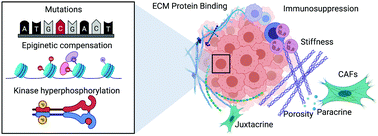Materials-driven approaches to understand extrinsic drug resistance in cancer
Abstract
Metastatic cancer has a poor prognosis, because it is broadly disseminated and associated with both intrinsic and acquired drug resistance. Critical unmet needs in effectively killing drug resistant cancer cells include overcoming the drug desensitization characteristics of some metastatic cancers/lesions, and tailoring therapeutic regimens to both the tumor microenvironment and the genetic profiles of the resident cancer cells. Bioengineers and materials scientists are developing technologies to determine how metastatic sites exclude therapies, and how extracellular factors (including cells, proteins, metabolites, extracellular matrix, and abiotic factors) at metastatic sites significantly affect drug pharmacodynamics. Two looming challenges are determining which feature, or combination of features, from the tumor microenvironment drive drug resistance, and what the relative impact is of extracellular signals vs. intrinsic cell genetics in determining drug response. Sophisticated systems biology tools that can de-convolve a crowded network of signals and responses, as well as controllable microenvironments capable of providing discrete and tunable extracellular cues can help us begin to interrogate the high dimensional interactions governing drug resistance in patients.

- This article is part of the themed collection: Soft matter aspects of cancer


 Please wait while we load your content...
Please wait while we load your content...